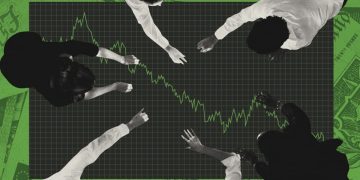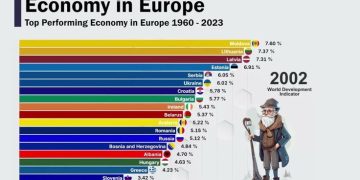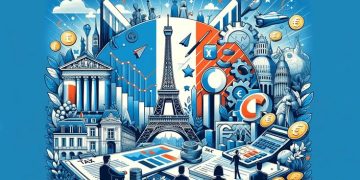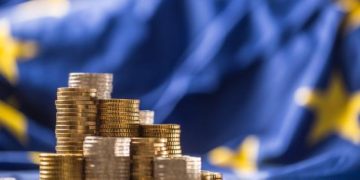The Euro’s Paradox: Why Europe’s Currency Remains Strong Despite Monetary Easing and Economic Weakness
1. Introduction: The Currency That Refuses to Fall
The euro, one of the world’s most traded and influential currencies, has long been seen as a barometer of the European Union’s economic health. Conventional economic logic suggests that when a central bank cuts interest rates, expands liquidity, or signals further easing, the currency typically weakens.
Yet in recent cycles, despite the European Central Bank (ECB) engaging in multiple rate cuts, shrinking economic momentum, and sluggish productivity growth, the euro has remained surprisingly resilient. In several periods during 2024–2025, the euro even strengthened against the U.S. dollar, British pound, Swiss franc, and Japanese yen—currencies backed by stronger growth or tighter policy stance.
This is the paradox:
Why does the euro show strength in moments when economic fundamentals appear weak?
To understand this, we must go far beyond simple interest-rate explanations. The euro’s resilience is deeply rooted in structural shifts within global capital flows, trade dynamics, central bank reserve allocations, energy market transitions, and the perception of Europe as a “safe neutrality zone” amid intensifying geopolitical blocs.
This article explores the structural, macroeconomic, and geopolitical reasons behind the euro’s unexpected strength, evaluates whether this strength is sustainable, and analyzes the long-term implications for European competitiveness, trade, inflation, and policy design.
2. The Traditional Rulebook: Why the Euro Should Have Weakened
Before analyzing the paradox, it is essential to understand the theoretical expectations:
2.1 Rate Cuts Typically Depreciate Currencies
In textbook macroeconomics, lower interest rates reduce the return on a currency, making it less attractive to foreign investors. This normally results in:
- Capital outflows
- Declines in exchange rate value
- Lower demand for the currency
Europe’s rate cuts should, under normal circumstances, have weakened the euro.
2.2 Weak Growth Usually Deters Investors
The euro area has suffered from:
- Stagnant GDP growth
- Weak industrial production
- Slow labor productivity
- Investment gaps compared to the U.S. and Asia
Historically, weak growth correlates with weaker currency performance.
2.3 Inflation Moderation Normally Pressures Policy
As inflation cooled, financial markets expected the ECB to maintain easing, further pressuring the euro.
Yet none of this played out as traditionally expected.
Why?
The answer lies in structural changes that reshaped global currency demand.
3. Structural Drivers Behind the Euro’s Unexpected Strength
3.1 The U.S. Dollar’s Uncertainty Creates Room for Alternatives
The U.S. dollar remains the world’s dominant reserve currency, but in recent years, several destabilizing factors have reduced investor confidence:
- Rising U.S. fiscal deficits
- Growing political polarization
- Concerns over government shutdowns and debt ceiling standoffs
- Slowing economic momentum
- Uncertain Federal Reserve policy path
Global investors seeking a hedge against dollar volatility increasingly diversify into the euro.
Even a modest shift from dollar reserves into euro reserves creates strong upward pressure on the euro.
3.2 The Euro’s Role as a “Neutral Reserve Asset”
Unlike the U.S. or China, Europe is perceived as:
- Politically stable
- Geopolitically neutral
- Militarily less interventionist
- Less exposed to sanctions risk
For many international reserve managers—especially in Asia, the Middle East, and Africa—the euro is a safe, politically neutral alternative to the dollar.
This structural shift boosts euro demand independently of ECB rate policy.
3.3 Strong European Trade Surpluses Support the Euro
Europe consistently runs a surplus in:
- Machinery
- Pharmaceuticals
- Automotive products
- Chemicals
- High-end manufacturing
- Green technology and clean energy equipment
These surpluses mean global buyers must purchase euros to buy European goods.
Even during periods of low growth, Europe’s exports remain highly competitive—supporting the currency.
3.4 The Energy Shock Reversal: From Crisis to Balance
During the 2022–2023 energy crisis, Europe’s massive energy imports (especially LNG) weakened the euro.
But in 2024–2025, several positive shifts occurred:
- Energy prices stabilized
- Europe diversified away from Russian gas
- Renewable energy capacity expanded
- Industrial efficiency improvements reduced demand
- Warm winters reduced consumption
This led to a dramatic improvement in Europe’s trade and current account balances, strengthening the euro.
4. The Role of Global Capital Flows
4.1 Large Inflows into European Bonds
Even though ECB rates fell, European bond yields remained attractive for several reasons:
- High credit quality (Germany, Netherlands, France)
- Deep and liquid sovereign markets
- Low political default risk
- Attractive risk-adjusted yields vs. Japanese or Chinese bonds
Investors continued to purchase European fixed income for safety, not yield.
4.2 Corporate Investment Flows
Many multinational corporations increased investment in Europe due to:
- EU industrial subsidies
- Green transition incentives
- Proximity to global markets
- Stable regulatory environment
Foreign direct investment (FDI) supports the euro because companies must use euros to operate within the region.
4.3 Portfolio Diversification: A Multi-Polar Currency World
Global investors increasingly diversify currency exposures across:
- USD
- EUR
- JPY
- CNY
- CHF
The euro benefits disproportionately from these diversification flows because:
- It is liquid
- It is stable
- It is institutionally backed
- It is widely accepted in global markets
This long-term trend provides persistent upward pressure on the euro.

5. The Euro’s Strength Is Also a Reflection of Others’ Weakness
5.1 Weak Chinese Growth Weakens the Yuan
As China faces structural slowdown, the yuan has weakened, pushing investors toward the euro.
5.2 Japan’s Struggles Drag Down the Yen
The Bank of Japan remains cautious about rate hikes, limiting yen appreciation.
5.3 Britain’s Fragility Impacts the Pound
Post-Brexit economic uncertainty and productivity stagnation weaken the pound, making the euro relatively stronger.
5.4 Emerging Market Volatility Creates “Safe Haven” Flows
When emerging markets face risk—including currency crashes, debt crises, or political instability—money flows into:
- USD
- EUR
- CHF
Europe benefits as an alternative safe haven.
6. Monetary Policy Divergence: Not as Simple as It Seems
6.1 The Federal Reserve’s Slow Easing Path
While the ECB cut rates aggressively, the Federal Reserve moved more cautiously. Markets interpreted this as:
- ECB easing is temporary
- Fed tightening has peaked
- Rate differentials may narrow
This resulted in less downward pressure on the euro.
6.2 Markets Look at Real Rates, Not Nominal Rates
Even though Europe cut rates, real interest rates (rate minus inflation) remained competitive.
In several quarters, Europe’s real rates were higher than those of the U.S.—a bullish factor for the euro.
6.3 Forward Guidance Signals Confidence
When the ECB signaled measured, controlled easing rather than panic-driven cuts, markets interpreted this as stability rather than weakness.
Confidence boosts currencies, even during easing cycles.
7. Why a Strong Euro Is a Problem for Europe
Despite its resilience, a strong euro creates multiple economic challenges.
7.1 Export Competitiveness Declines
A stronger euro makes European goods more expensive:
- German machinery
- French aerospace
- Italian textiles
- Spanish agriculture
- Dutch semiconductor components
This reduces European competitiveness, especially versus:
- U.S.
- China
- South Korea
- Japan
7.2 Imported Deflation Pressures Intensify
A strong euro reduces import prices:
- Energy
- Food
- Raw materials
- Consumer goods
This creates deflationary forces that complicate ECB policy.
7.3 Corporate Profit Margins Compress
Multinationals with global operations face:
- Higher export prices
- Lower foreign earnings when converted back into euros
This disproportionately affects:
- BMW, Mercedes, Volkswagen
- LVMH, Kering
- Airbus
- Siemens
- European technology manufacturers
7.4 Economic Growth Slows Further
A strong euro:
- Hurts exports
- Weakens manufacturing
- Reduces investment incentives
This creates a feedback loop that pressures the broader economy.
8. Is the Euro’s Strength Sustainable?
8.1 Structural support is strong
The euro is supported long-term by:
- Large, consistent trade surpluses
- Global diversification away from the dollar
- Europe’s position as a geopolitical neutral zone
- Deep bond markets
- A stable regulatory environment
- A green energy and sustainability leadership role
These long-term strengths will not disappear soon.
8.2 But cyclical headwinds may weaken it over time
The euro faces future risks:
- Weak growth
- Industrial contraction
- Demographic decline
- Slow innovation
- Limited fiscal union
- Fragmented banking and capital markets
These factors could contribute to future depreciation.
8.3 The most likely scenario
The euro is likely to remain:
- Stable
- Moderately strong
- Supported by structural capital flows
but increasingly torn between:
- Strong international demand
- Weak domestic fundamentals
In other words:
The euro may stay strong globally even as Europe struggles economically.
This is the heart of the euro paradox.
9. Conclusion: A Currency Built on Confidence More Than Growth
The euro’s strength in recent years defies traditional macroeconomic models. The euro is increasingly:
- A geopolitical hedge
- A reserve diversification tool
- A safe asset in a volatile world
- A symbol of regulatory and institutional stability
Its value is no longer determined solely by:
- Interest rates
- Inflation
- GDP
- Trade balances
Instead, the euro is a structural currency, backed by a complex global system of credibility, neutrality, and financial integration.
This paradox—strength without growth—reflects the unique nature of modern Europe:
a continent struggling economically, yet trusted financially.
Whether this paradox can continue is one of the most pivotal financial questions of the coming decade.
































